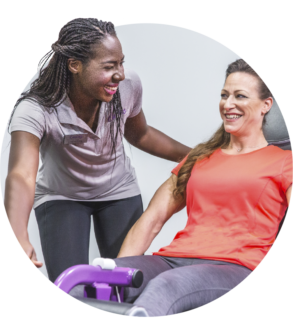Beyond Calcium—Building Strong Bones
Make no bones about it—osteoporosis is a serious health issue. Roughly one in every two women in the United States over the age of 50 will break a bone because of this disease.1 When you were a kid, if you broke your arm falling off a bike, the doctor would set it in a cast and six weeks later, you were good as new. When you’re older, recovery from fractures and breaks can be slow and painful.
Though it might seem like bone is solid, unchanging tissue, it constantly goes through remodeling, breaking down, as our body uses calcium, and building up. All of us—women and men—reach our peak bone mass in our 20’s. After that, bone density declines2. In women, estrogen helps protect against too much bone loss, so once we hit menopause and estrogen levels plummet, the risk of osteoporosis skyrockets. You can mitigate that risk with calcium-rich foods and regular exercise of the right kind.
How to increase bone strength
It’s never too late to boost your bone strength, and it becomes even more critical when, post menopause, your level of protective estrogen drops. After all, you want to keep up with your Curves whole body workout. To strengthen your bones and help to prevent osteoporosis, follow this 4-step strategy.
Step One – Be a dairy aficionado
Calcium rules when it comes to building strong bones, and the best source of calcium is dairy. An 8-ounce glass of low-fat milk or a typical 6-ounce container of low-fat yogurt delivers roughly 300 mg of calcium. Greek yogurt, however, contains about 200 mg of calcium—still plenty, but keep that in mind when you’re calculating calcium intake. Women under 50 should get 1,000 mg a day and 1,200 mg if you’re over 50. It’s best to get calcium through a healthy meal plan. But if you can’t get enough through food, which you might not if you are following a weight loss eating plan, take a calcium supplement along with vitamin D and magnesium for the best absorption.
Other foods rich in calcium3 that you should add to your healthy diet are canned salmon or mackerel with bones, broccoli, leafy greens, Chinese cabbage, and fortified foods. Spinach—though rich in calcium—contains oxalic acid, which prevents absorption.
Step Two – Get what you need in Vitamin D
D is the king of vitamins for bone health. It helps with absorption of calcium from food, and it pulls calcium into the bone. Getting adequate vitamin D also helps prevent falls because it helps with muscular function. Many of us don’t get adequate vitamin D, even when we follow a healthy eating plan. It’s available in only a few foods and, though our body can make vitamin D when exposed to sunlight, sunscreen interferes. You need UV rays to make vitamin D, and when you block them, you prevent vitamin D synthesis.
The United States Institutes of Medicine4 recommends 600 IU daily for children and adults (800 if you are over 70), and the National Osteoporosis Foundation5 advises women over 50 consume 800 to 1,000 IU a day as part of a healthy eating plan.
Dietary sources of vitamin D: The only truly good dietary sources of vitamin D are fortified milk and fatty fish, such as salmon, tuna, and mackerel. An egg yolk provides a modest 44 IU of vitamin D, fortified cereals and beverages may have added D as do calcium supplements.
If you think you’re not getting enough D from foods, talk with your doctor about whether you should get a blood test and perhaps take supplements if your level is low.
Step Three – Fill up on fruits and vegetables
Other nutrients that nurture bone health include magnesium, potassium, vitamin C, and vitamin K, and the best sources of these vitamins and minerals are fruits and vegetables. Bone is living tissue, and it needs a variety of nutrients for optimal health and function.
Some top picks in produce:6 Eat a wide variety of vegetables and fruits including dark green, leafy vegetables such as kale, collard greens, broccoli rabe, and Bok Choy; soy beans; broccoli; dried figs; and oranges.
Step Four – Strengthen your bones with exercise
Weight bearing activities, such as strength training, running, jumping rope, dancing—anything you do on two legs that requires your body to support your weight against the forces of gravity as you move—may help increase bone density. As you impact the ground, stress is felt in your bones from your feet on up your spine, and that stress stimulates bone building.
In addition, the National Osteoporosis Foundation7 recommends you engage in the following four types of exercises as part of your workout plan:
- Posture exercises: These exercises work to improve your posture, preventing rounded or sloping shoulders. They can help reduce your risk of breaking a bone, especially in your spine.
- Spine-strengthening exercises: These exercises help strengthen muscles in your hips and back.
- Balance exercises: These exercises strengthen your legs and improve your balance. They help prevent falls. For balance, consider regularly attending the Curves Balance Class.*
- Functional exercises: Functional exercises help strengthen your core and help improve your function in everyday activities. They also help reduce risk of falls.
Resistance training, like the kind you do as part of your full body workout at Curves ladies only gym, also puts load on your bones and is another good way to deepen density.
Why women need to take osteoporosis seriously
Osteoporosis is a serious health concern, especially for women. Approximately 10 million Americans8 have osteoporosis, and another 44 million have low bone density, which places them at increased risk for the disease. Following a healthy eating plan rich in calcium and vitamin D and engaging in a full body workout are important for preventing this disease throughout your entire life. You reach peak bone mass in your early 20’s—the higher your bone mass at that time, the lower your risk of osteoporosis later. Unfortunately, those who are most lacking calcium in their diets are girls and young women. So, as you steer your own healthy eating plan and exercise routine toward building stronger bones, consider guiding your daughter or granddaughter toward regular exercise and bone-building foods, too.
How exercise and diet help keep bones healthy
Not only can a regular workout plan help you maintain a healthy weight as you get older; it can keep your bones strong. The National Institutes of Health Osteoporosis and Related Bone Diseases National Resource Center9 reports that exercise can be very effective for improving bone health, increasing muscle strength, and helping you maintain good coordination and balance as you age. Strength training for women is one of the best ways to maintain strong, healthy bones—and you don’t need to spend hours doing resistance exercises to reap the rewards!
Whether you’re performing a full body workout in the Curves circuit or at home with MyCurves On Demand, or doing other weight-bearing exercises, make sure you’re challenging your muscles regularly with a good resistance training gym workout. Strength training for women who want to lose weight or just stay in shape is a great way to build muscle strength and keep your bones strong. Research10 shows that regular strength training can help prevent chronic bone-related diseases, such as osteoporosis and sarcopenia.
Watch what you eat
A regular exercise routine is important, but you also need to pay attention to your diet, regardless of whether you are following a weight loss eating plan. Eat plenty of calcium-rich foods and refrain from excessive alcohol consumption to reduce the risk of medical conditions that contribute to bone loss. Follow a healthy eating plan that consists of nutrient-rich foods, including these calcium-rich foods recommended by the International Osteoporosis Foundation11: yogurt, milk, cheese, broccoli, kale, nuts (especially Brazil nuts and almonds), sardines, figs, and calcium-set tofu.
Be consistent
Sticking to an exercise routine that includes both resistance training and a cardio workout can help you build strength and reduce your risk of bone loss. Maintaining a positive lifestyle by including functional activities in your daily routine can also improve your overall health and well-being as you get older. Following a healthy eating plan rich in calcium and vitamin D also helps keep bones strong. Do whatever you can to be consistent with all your fitness relationship goals and healthy eating plan, and you’ll be giving your bones the best possible shot at maximum strength and stability well into your later years.
A regular exercise routine that combines strength and weight bearing exercise like the Curves workout or MyCurves On Demand—coupled with a healthy eating plan—is one of the best ways to help combat osteoporosis. And the optimal time to start thinking about bone health is now; the earlier in life you start taking these steps to protect your bones, the stronger they will be.
Combat osteoporosis with the Curves circuit
Make no bones about it, strengthening your human hardware is as important as putting more power in your muscle. Just take a look at these eye-opening osteoporosis facts:
- As many as 50 percent of women1 over the age of 50 will break a bone due to osteoporosis.
- Post-menopause, a woman can lose up to 20 percent of her bone density.
- A woman’s risk of breaking a hip equals her combined risk of breast, uterine, and ovarian cancer.
Here’s another fact—exercise is essential to keeping your bones strong throughout your life, and the Curves Circuit provides a perfect venue for building bone and muscle and pushing back osteoporosis.
The Curves circuit solution
What is the best exercise for strengthening your bones13 and helping prevent osteoporosis? Exercises such as jogging, dancing or jumping rope force you to work against gravity and involve impact with the ground. We traditionally think of these high-impact activities as the best prevention against osteoporosis but strength training is also effective. Both activities put stress on the bone and create micro-trauma, which triggers bone remodeling and repair. Just as muscle gets stronger when it bears weight, so does bone.
The Curves Circuit does double duty against osteoporosis14 because it includes both strength training exercises (on the machines) and cardio (on the machines and on the mats).
And there’s a bonus to being a Curves member, because while it is important to strengthen your bones against osteoporosis, it is equally important to build muscle strength and better balance to prevent falls. Curves offers a Balance Class* and a Boxing Class,* both of which can improve your stability.
Exercise is one of the best ways to combat osteoporosis, and the Curves circuit will keep you standing tall and strong. Visit ‘Why Curves’ to find out more about Curves, or find your nearest gym and talk to one of our Curves Coaches!
Sources
- National Osteoporosis Foundation: What Women Need to Know
- National Institute of Health
- National Osteoporosis Foundation: Calcium and Vitamin D
- National Institutes of Health: Vitamin D
- National Osteoporosis Foundation: Calcium and Vitamin D
- National Osteoporosis Foundation: Calcium and Vitamin D
- National Osteoporosis Foundation: Osteoporosis Exercise Examples
- National Osteoporosis Foundation: Osteoporosis Fast Facts
- NIH Osteoporosis and Related Bone Diseases
- Endocrinology and Metabolism Journal
- International Osteoporosis Foundation
- Medline Plus
- National Institute of Health
- National Osteoporosis Foundation
*At participating locations only.







